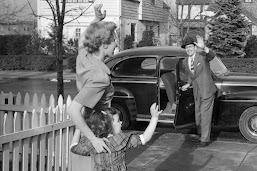In February, my U.S. History students were immersed in the fast-moving, lucrative world of 1950s USA! The early years of the Cold War is an interesting period to study since so much in society, politics, and the economy were changing; this era is officially the start of what historians call "modern history", since much of the cultural elements introduced in the 1950s still exist today (including highways, credit cards, & fast food). I streamlined my lessons to ensure that all my students mastered the themes and state standards of the 1950s; lectures, notes, engaging assignments, and productive table-partner review sessions were used to achieve a high content-retention rate among students. The classroom resources that I created and used to resounding success are found below, free for my fellow educators!
Lectures (created by Mr. Chanin, 2023) - these colorful and informative presentations were used as the "skeletons" of my 1950s lessons, incorporating the state standards and academic vocabulary my students were tasked to become familiar with over a 3-week period. Students were responsible for taking notes on the lectures, which were later used during small-group review sessions. After the lecture and a teacher-led discussion on the significance of that specific portion of the 1950s, students were assigned an interactive activity or assignment that paired well with the material they had just learned. Each lecture has a brief synopsis/recap at the end.
Origins of the Cold War Lecture - 1st lecture in the 1950s series includes content on Stalin, capitalism v. communism, Iron Curtain, containment, Truman Doctrine, Marshall Plan, NATO & the Warsaw Pact
Cold War Expands Lecture - 2nd lecture in the 1950s series includes content on Eisenhower, Berlin Airlift, fall of China, Korean War & Douglas McArthur, the Arm's Race, H-Bomb, and brinkmanship
Cold War at Home Lecture - 3rd lecture in the 1950s series includes content on communism in the streets, House Un-American Activities Committee, Alger Hiss & the Rosenbergs, McCarthyism, and Atomic Age
Peace & Prosperity Lecture - 4th lecture in the 1950s series includes Truman's Fair Deal, McDonalds & consumer culture, baby boom, Levittowns, "Sunbelt", Interstate Highway System, & poverty inequality
-----------
Assignments (created by Mr. Chanin, 2023) - these tasks range from notes templates (which students diligently complete during the lectures) to engaging worksheets that further develop students' mastery of the content. Each worksheet has simple, purposeful instructions.
Cold War Map Activity - since the early years of the Cold War occurred in post-WWII Europe, I believe it is best to introduce the unit with a map activity to give the students a spacial awareness of where these events happened (geography is a key tool to master in social studies classes).
McCarthyism Worksheet - this modified C-Span worksheet partners well with the third lecture on Senator Joseph McCarthy and his impact on Cold War politics. Students grasp a greater understanding on traitors, suspicion, and McCarthyism via 1950s newsreel clips.
Witch Hunt Activity - this engaging activity is always a treat for students after they have become familiar with McCarthyism. Students are given either a "Communist" or a "Loyal" notecard as well as an 1950s occupation (housewife, actor, movie director, etc.). They are then placed into groups - the objective of the game is to avoid being accused of being a Communist spy while also attempting to rid your group of suspects who have aligned themselves to the Soviet Union. My students enjoy these fun, interactive ploys where they are able to move around, have a chuckle, and learn a key concept in a meaningful, memorable fashion. Instructions to the activity should be given before the students are given notecards/in groups.
Origins of Cold War Notes - this is the first notes document of the Cold War lecture series.
Cold War Expands Notes - this is the second notes document of the Cold War lecture series.
Cold War at Home Notes - this is the third notes document of the Cold War lecture series.
Peace & Prosperity Notes - this is the fourth and final notes document of the Cold War lecture series.
My American Dream Activity - my students thoroughly enjoyed this interactive activity and thought it was a "blast"! This is a simulation game (not created by me, yet I found it online and created a worksheet) that puts the students in the shoes of either a man or a woman in the 1950s. Students are then able to make consequential choices in their virtual life (including going to college, getting married, having babies, buying a car, etc.). In completing this activity, my students were able to better visualize the prosperous culture of 1950s America. Students should individually play this game after the 4th lecture.


